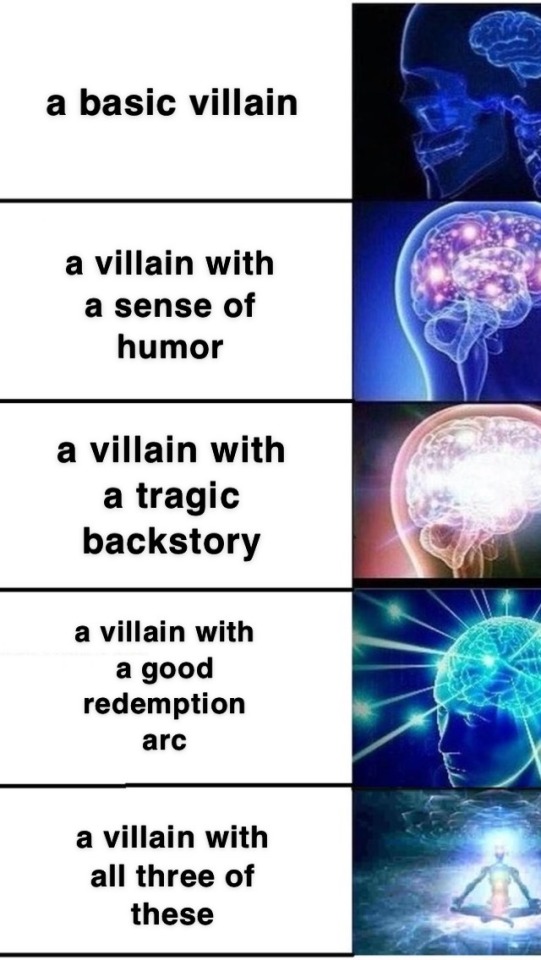Nyx | She/her | Most of my WIPs are 11 pm thoughts ngl
Don't wanna be here? Send us removal request.
Text
I need more writeblrs to follow!
Reblog this if any of the following apply and I'll check your blog out:
You post original writing
Your WIPs have a diverse cast
You write fantasy (any kind of fantasy)
You post/reblog writing advice
You like interacting with other writers
Also if you like being tagged in tag games or participate in Storyteller Saturday, let me know in the tags! ❤️❤️
(I follow from @mymainbloghere )
476 notes
·
View notes
Text
How to Use Tags Effectively in the Writeblr Community
[This is an expanded version of the “Using tags effectively” section on my How to gain attention in the Writeblr Community guide here. Please check that out as well!]
This is a question I get often, and it’s really difficult to figure out how this works on your own, so here’s a handy little guide!
So in order to figure out how to use tags, we have to know how tagging works on Tumblr.
How tags work on Tumblr
Only the first five tags will show up in tracked tags. (i.e., if you tag your post #writeblr, and I’m following the tag #writeblr, it might pop up on my dashboard even if I’m not following you.)
Only the first twenty tags will show up in tumblr search.
Reblogs will not show up in tracked tags or search.
Hyphens (-) won’t show up in tracked tags.
That’s a lot to remember, are you still with me? The most important thing to remember about tagging your work is that the first five tags are the most important. You want to use your biggest, most relevant tags in the first five.
What tags you should use
So you know that the first five are most important, but what tags should you use? What tags are the best?
Here’s what I usually use and though I don’t know if they’re particularly popular or not, but they’ve worked for me just fine.
Tags to use for any writing-related post
#Writeblr and #writing for any writing-related post that you make. These two are the most important tags. I also sometimes include #writblr because some people use that tag instead.
If you have spare room in your first five tags, because you don’t have anything else to tag it with, try using #writers of tumblr, #writeblr community and #writers to maximize your tagging potential. These should only be used in your first five if you have extra space!
Tags to use for your original writing
#creative writing, #amwriting, #original writing, are a fantastic place to start.
Remember to tag your genre as well, like #fantasy, #science fiction, #urban fantasy, #young adult, #YA, depending on what you write for.
Tagging your writing type can also be effective, such as #drabble, #flash fiction, #excerpt, etc., if they are relevant.
Tags like #angst, and #fluff are also really popular, so if either of those apply to your writing, try including that!
If you have some additional space, #WIP, #WIPs, #OC, #OCs also will work, depending on what you’re posting about.
Tags to use for writing advice
#writing advice, #writing help, #writing tips are the most commonly used ones.
You can and probably should specify what your writing advice is about like #description, but that can wait for the tags after the first five.
Tags to use for relatable writing content and memes
#just writer things, #writing memes, #writing meme are the biggest ones in Writeblr, I believe.
#writing problems also work depending on what your post is.
Other tags not specific to the writing community like #memes, #relatable also work, for an even broader audience outside of Writeblr.
Tags to use for writing encouragement and positivity
#writing positivity, #writing encouragement are commonly used.
Other tags not specific to the writing community like #positivity and #encouragement also work, for an even broader audience outside of Writeblr.
Which tags you should use
So that’s a lot of potential tags to use, and only the first five will show up in tracked tags! How in the world are you going to prioritize?
Figure out what type of post you’re making, and don’t get greedy! If it’s not a writing meme, don’t tag it as such. The best way to maximize your tag usage is to use a combination of various tags that are the most relevant to your post. Try mixing and matching and experimenting!
What to do after the first five tags
The first twenty tags will show up in search, and also the organization of your personal blog tags. For example, I use #Undine writes stuff to organize all of my original writing on my blog — chances are, people aren’t following that tag, but it’s important to my writeblr. Your next priority should be your organizational tags for your own blog.
You can also include some tags that you couldn’t fit in the first five! Again, the first twenty will show up in search so if you think someone might search a particular tag, it’s a good idea to include it as well.
And finally, any comments that you want to leave in the tag should be after you get all of your important tags out of the way!
Your personal writeblr tag
So a lot of writeblrs like to use their own url as tags whenever they make an original post, so people can find it easily.
However, if you’re like me and your url has hyphens in it, it will not show up anywhere! So instead of #pens-swords-stuff, I use #pens swords stuff.
This also goes for all of your people tagging other writeblrs in your hashtags — if they have a hyphen in their url, try writing it out without the hyphens so it’ll show up!
Don’t bother trying to use popular tags for reblogs
Your tags won’t show up in any tracked tags or searches if it’s not an original post! When you reblog someone else’s posts, you can forget the first 5 tag rule, and just jump straight into your organizational tags and your tag comments.

If you’d like to ask me for advice on writing or running a writeblr, please check out my Ask Guidelines and FAQ first.
Ask Guidelines | FAQ | Advice Masterlist
5K notes
·
View notes
Text
ATTENTION
I AM ON A MISSION. I AM GOING TO FOLLOW EVERY FUCKING BLOG ON THIS SITE. ALL OF THEM. HELP ME ACHIEVE THIS GOAL, INTERNET STRANGERS, BY REBLOGGING THIS POST AND I WILL FOLLOW ALL WHO REBLOG IT. E V E R Y O N E.
433K notes
·
View notes
Text
m h m
the whole being gay and liking the same gender thing is a lot to take in, person a has been straight most of their life but now it's changing: because of person b's welcoming smile. it really surprised them that: they actually like person b, who's their friend since forever ago. it does make sense because the only thing person a was thinking about is how to make person b happy, all the time; or how they always smile at the thought of person b's mere presence.
of course, with the new changes in their preference: person a tries to avoid person b, saying that they hate them; when really, they really like them. they thought if they push person b away, the guilt anchor would be raised but really it just sunk deeper into the deep, black ocean of emotions. not only did they hurt themself, they hurt person b, too: and person a wanted to change that, for the better.
77 notes
·
View notes
Text
Hi!! Welcome to the community!!
New Writeblr on the block

Hey everyone! I go by Scarlet. This is my new writeblr and I write about things from adventure/fantasy to romance. I’m honestly open to any type of stories but my favorite type is fantasy, fiction, romance or perhaps all! I’m looking forward to expanding my genres too!
English isn’t my first language but I prefer speaking in English. I also happen to have a wide English vocabulary—I read—than most of the people I know.
I’m so excited to join you guys since I’ve been stalking watching your community from a far and you guys seem amazing! I’m hoping I can get some advice and perhaps motivation from here.
I might be posting a WIP that I’ve been working on here. The only issue? I can’t seem to get the words out—but we’ll get there later. I’m sure I’ll meet amazing people that’ll convince me and give me energy to finish my work in due time.
I write for fun and I either have 9248 WIPs at once or 0, none in between. I’m hoping I can control that eventually—also, if you have any advice on that, do tell. I’m desperate.
I’m looking for writeblr friends and perhaps someone who can help me through this? I’m looking forward to interacting with you all.
112 notes
·
View notes
Note
Hello! I hope you're well! I was wondering, do you have some advice for the best-friends-to-lovers trope? My characters have been best friends since childhood and start living together but I have trouble getting the romance going as they're already very affectionate towards each other.
I’ve written quite a few articles surrounding the subject that I thought might be helpful, so I’ve linked them below :)
Guide to Writing Friends To Lovers
Tips On Writing Skinny Love
Resources For Romance Writers
Resources For Describing Emotions
Relationships Between Characters With No Connection
Relationships Between Polar Opposites
Skinny Love Prompts
Enemies Turned Lovers Prompts
Best Friends Turned Lovers Prompts
Tol & Smol Prompts
Guide to Writing Enemies To Lovers
“Just Friends” Playlist Listen On Spotify
Childhood Friends to Lovers
Hope these can help you!
VISIT THE WORDSNSTUFF WEBSITE AT WORDSNSTUFFBLOG.COM
If you enjoy my blog and wish for it to continue being updated frequently and for me to continue putting my energy toward answering your questions, please consider Buying Me A Coffee or supporting me on Patreon.
Wordsnstuff also has a newsletter, which you can subscribe to by filling out the pop up on wordsnstuffblog.com.
I’d also really appreciate it if you would check out my separate blog dedicated to my current work in progress. I also run writing sprints over on snapchat.
4K notes
·
View notes
Text
Can some writeblr’s reblog this?
My dash feels devoid of writers and I want too read people’s work and interact?
644 notes
·
View notes
Text
Slowly slipping out of writer’s block is:
• coming up with a vague concept that sparks something in your brain. Not really excitement yet, but it’s not numbness and despair so it might be worth nurturing?
• creating a Pinterest board for your aesthetics, until you get mental images of your idea
• making a Spotify playlist full of songs that might fit said aesthetics (and cursing yourself because you don’t have Spotify Premium and have to listen to 3 ads in a row urgh)
• having random scenes that start to pop in your head? Characters, relationships, things
• still no plot or even premise, though. You’re just shamelessly indulging on all these little things until you can pull yourself together and work on it for real
• seriously take your time, it’ll come eventually
5K notes
·
View notes
Text
WORDS TO USE INSTEAD OF: SCARED
Do you ever find yourself over-using the word “scared” to describe characters in your writing? Try using these words instead:
terrified
horrified
worried
spooked
afraid
paranoid
anxious
aghast
hesitant
panicked / panicky
concerned
nervous
startled
petrified
scarred
traumatized
frightened
fearful
shocked
shaken
4K notes
·
View notes
Text
Never mow the same grass twice — How to improve faster as a writer
One of the most important writing lessons I ever learned came, surprisingly, from my college trumpet instructor.
“Michael,” he’d say with a heavy sigh, pulling off his glasses and rubbing the lenses with the bottom of his shirt. “You know I hate to mow the same grass twice.”
It was a phrase he used a lot, in band and private lessons, whenever someone made a mistake he’d already told them to correct. Because in his mind, once he’d identified a mistake in your performance, you needed to do everything you could to keep it from happening again, for two reasons.
First, because as he said, he doesn’t like to mow the same grass twice. And second (and more importantly), because if you let yourself repeat a mistake, that mistake will start to become a habit.
A bad habit.
And the more you let yourself repeat that habit, the more deeply ingrained it becomes, making it increasingly difficult to fix and slowing your progress as a musician (or artist, or writer). So his suggestion was this: Identify what needs to change, and firmly commit to fixing it now.
Confession Time
So. I was a very average trumpet player. My instructor and I had a great rapport, but he had to tell me to mow the same grass twice, three times, and more often than he ever would have liked, because I just wasn’t focused or passionate enough about trumpet to fully commit to his advice.
But I was focused and passionate enough about fiction to commit to his advice when it came to writing. So I applied his mindset in my creative writing workshops, particularly when I started my MFA.
And I tell you what, everybody. It worked wonders — helping me improve enough in that first year alone to win our MFA program’s top fiction prize and to earn a teaching assistantship.
3 Steps to Quickly Improve Your Writing
With my trumpet instructor’s advice in mind, I put a 3-step process on loop throughout my time in the MFA:
Share a short story with your fellow writers. (A workshop is great, but online writing friends work too.)
Sift through everyone’s feedback to find one high-priority ��bad habit” in your writing that they seem to be honing in on.
When you sit down to write your next story, commit to breaking that habit at any cost, even if it means making other mistakes because of it. (New mistakes are better than old mistakes.)
This is How it Went for Me
The first short story I shared in my MFA workshop had a clear issue: the narrator was passive and underdeveloped. One of my classmates called him a “window character,” someone through whom we could observe the other, more interesting characters who actually drove the plot. The rest of the workshop agreed, and looking back at some of my past stories, I realized that passive narrators had become a deeply ingrained habit of mine.
So the next time I wrote a story, I strictly committed myself to writing a more active narrator.
The Result?
A moderately active narrator. Not perfect, but better than I’d done in a long time. It was progress — me chipping away at the bad habit.
The next story I wrote showed much more progress. It had a highly active narrator, and so did the story after that. And that’s when a new, better habit formed: writing active narrators without even thinking about it. And that let me shift my focus to improve upon something else (such as making all my narrator’s actions stem from their core emotional struggle). And something new again after that (using more figurative language, loosening up my writing voice, etc.).
And that’s how you can improve, too. The goal, again, is to use peer feedback to identify habits in your writing you don’t like, and then to mentally commit to replacing them with habits you want, one by one.
It’s a slightly different way to approach feedback. We tend to primarily use feedback as a way to help us improve an individual story — but it’s also a fantastic opportunity to improve your future first drafts.
You’ll be surprised how quickly your writing improves when you do this.
The key, though, is to commit to tackling just one major habit at a time. Why? Because writing is hard, friends, and fiction is a complex tapestry of various techniques, all coming together at once. That means your attention is always inevitably split while writing, so if you try to fix multiple habits at once, you’ll likely spread your attention too thin to succeed.
So identify a single change you want to see in you writing. Make it happen the next time you write a story, no matter what. Then, before you sit down again to write the next story, find something new you want to change or improve.
You’ll love what happens to your writing when you commit to never mowing the same grass twice.
And when you do, far away, in a brightly-lit college band room in Minnesota, my old instructor will raise a hand to conduct a trumpet ensemble, pause — and smile.
— — —
Your stories are worth telling. For tips on how to craft meaning, build character-driven plots, and grow as a writer, follow my blog.
4K notes
·
View notes
Text
The Many Faces of the Strong Female Character
The much-requested, positive counterpart to my classic “Female Characters to Avoid in Your Writing” and it’s much-later sequel.
Here, I will discuss some of my favorite fictional ladies and what makes them work so well; given my rapturous love of women, there will probably be a sequel! In the meantime, I talk more about portraying female characters here.
Happy writing, everybody! <3
1.) The Warrior
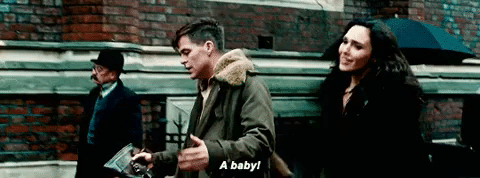
(Gif credit.)
When most people hear “strong female character,” they picture the most popular definition of the term: a stony-faced, emotionally shallow, conventionally attractive broad who punches and kicks stuff. She may occasionally shout things like, “I DON’T NEED NO MAN,” while perhaps punching a small baby.
I decided to start with my wife Diana, because she is the perfect antithesis of this trope. She isn’t stony, she’s courageous. She’s unabashed about showing her doubts, hopes, affections, and optimism. Her love interest never steals her spotlight, but she feels no need to shun romance to appear “strong.” She’s beautiful, but not sexualized or objectified.
And while most Strong Female Characters™ are ironically reduced to damsels in distress at some point in their own narratives, Diana consistently takes the lead, totally autonomous over her own story.
You can kick ass AND love babies, people. Joss Whedon, please take notes.
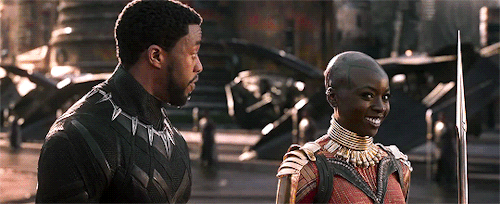
(Gif credit)
Other examples: Okoye from Black Panther, Furiosa from Mad Max: Fury Road, Rey from Star Wars, and Ser Brienne of Tarth from Game of Thrones.
2.) The Comedian
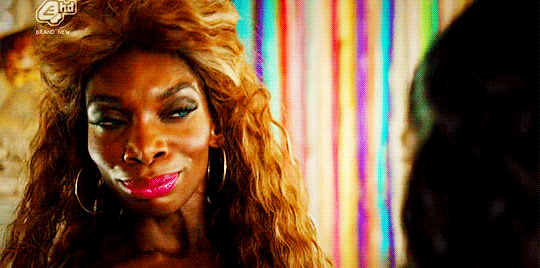
(Gif source)
If you haven’t watched Chewing Gum on Netflix, stop whatever you’re doing and watch it right now. Its relatively simple premise – a twenty-four-year-old from a fundamentalist Christian household struggles to lose her virginity – is a segway into a hilarious, genuine exploration of human sexuality, relationships, and how we forge our identities.
Brilliantly portrayed by the series’ creator, Michaela Coel, Tracy is essentially that one friend who knows exactly what you’ve been thinking and isn’t afraid to say so. She is never relegated to a single trope or stereotype. She’s stumbling, clumsily but enthusiastically, through the life experiences that shape us. Most importantly, she is allowed to be sexually curious, awkward, aggressive, insecure, and – I can’t stress this enough – hilarious. The dialogue is infinitely quotable, and endlessly relatable.
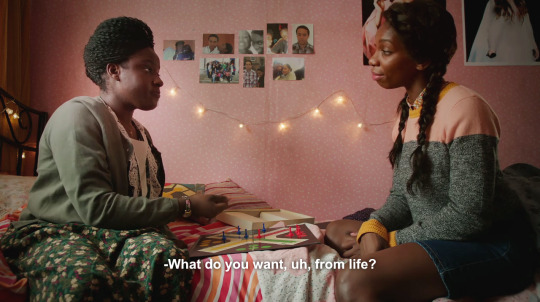
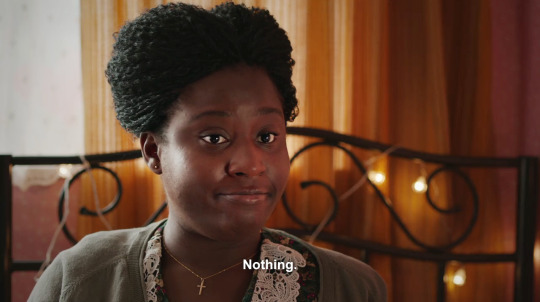

(Image source)
Watching shows like Chewing Gum makes me realize how few female characters – and even fe wer Black female characters – are portrayed as truly human. Typically, they’re allowed to be sexy, but not sexual. They’re allowed to be awkward, but only if it’s cute. They can be insecure, but only if that insecurity can easily be solved by the affirmations of a male love interest. And they’re rarely allowed to be the main source of a series’ comedy.
So remember: let your female characters be human. Let them be awkward, funny, sexual philosophers. It’s easier than you think.
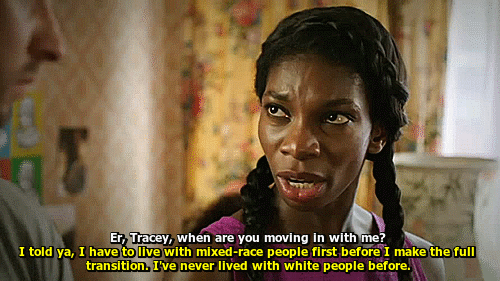
(Gif source)
Other examples: Abbi and Ilan from Broad City, Leslie from Parks and Rec, Tina from Bob’s Burgers.
3.) The Drama Queen

(Gif source)
Watching Riverdale is like hurtling along on a structurally unstable rollercoaster. It’s utterly insane, a lot of fun, and once you’re on, you can’t stop.
But amidst the explosions of batshit crazy plot points, killer cults, and the existential perplexity of finding yourself attracted to emo Jughead, there are some real gems. One of these is Cheryl Blossom, and pretty much every plot line surrounding her.
Cheryl is introduced as a fairly one-dimensional, catty mean girl, though the Regina George-esque charisma with which she’s portrayed makes her instantly likable. Initially, we expect her to be a character we’ll love to hate.
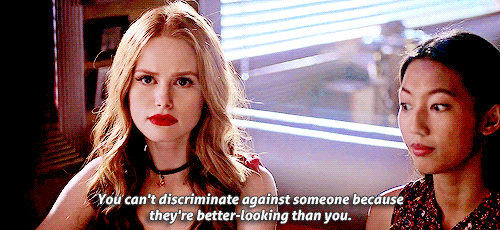
(Gif source)
And yet, within the first few episodes, I was impressed by how layered and complex her motivations were. Much of contempt towards others was misdirected rage from an upbringing of extreme emotional abuse, and grief over her dead brother – all portrayed without a Snape-style condonation of said behavior. By the end of season one, my thoughts were generally, “Oh, crap, I don’t think I can claim to be watching this ‘ironically’ anymore,” and “MORE CHERYL.”
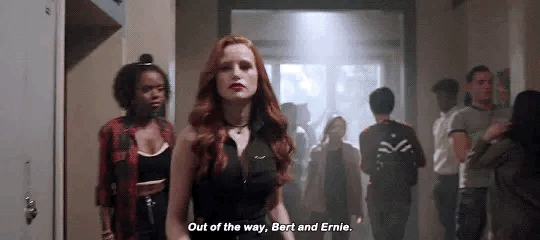
(Gif source)
Season two answered my wish, and then some. Cheryl was saved from an (impressively conscientiously portrayed) attempt at sexual assault by a pack of her female friends, and her attacker got the shit beat out of him in one of the most cathartic moments of modern television.
To the exaltation of my queer heart, she also came out as a lesbian, in a deeply moving story arc that I never would have expected from this show. Without spoiling too much, she and her new love interest kissing in front of anti-gay propaganda footage was legitimately one of the most powerful moments I have ever witnessed.

(Gif source)
Before the season was over, she viciously threatened her abusive, homophobic mother while covered in blood, shot a serial killer with a bow and arrow, and joined a gang. If that’s not gay culture, I don’t know what is.
Oh, how I wish this show was just about her.
Other examples: Alexis from Schitt’s Creek.
4.) The Lovable Bastard

(Gif source)
Ah, The Good Place. I have never experienced such a breath of comedic fresh air. A new philosophical principle each episode, examined and applied in hilarious and thought-provoking ways. A complete absence of harmful stereotypes. Incredibly lovable, three-dimensional, and ever-evolving characters.
I was considering using my queen Tahani for this list, who externally larger-than-life and internally vulnerable after emotional abuse by her parents. Also, she’s hilarious. Everyone and everything in The Good Place is hilarious. And I also thought about talking about Janet, who is the best character in anything ever, but of course:
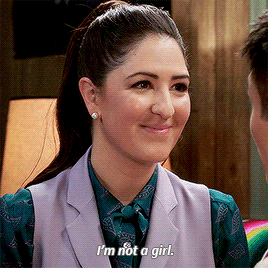
(Gif source)
Instead, I’ll be talking about bisexual icon Eleanor, who is something very few female characters get to be: the lovable bastard.

(Gif source)
Eleanor, when we first meet her, is not traditionally good in any sense of the word. She turned down a high-paying job because she was expected to be nice to people. She sold placebos to the elderly, and was great at it. She was drunken, slovenly, hedonistic, and selfish. And she’s instantly incredibly likable.
Why and how Eleanor is so enjoyable, even at her very worst, merits an essay all its own. But in a nutshell:
We empathize with her. We are introduced to “The Good Place” completely through her eyes. We are in her shoes.
The stakes are high. When we discover that her entry into the good place was a mistake, we want her to be okay.
We come to understand her, and how her terrible childhood shaped her destructive behavior.
She wants to be a better person, and with time, effort, and character development, we watch her become one.
Not only is this an amazing lesson in how to endear audiences to your character, it is also infinitely refreshing. The most famous lovable bastards are all men – Han Solo, Dr. House, Captain Jack Sparrow, the Man With No Name, et cetera – but women are rarely afforded the same moral complexity. If a woman in fiction has done bad things, she’s not usually a lovable bastard. She’s usually a bitch.
Eleanor isn’t just a great character. She conveys an important lesson: women are people. People with the same capacity for mistakes, growth, redemption, and love as anyone else.
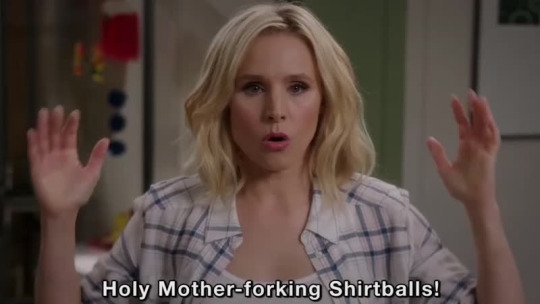
(Image source)
Other examples: Chloe from Don’t Trust the B*tch in Apartment 23
5.) The Cinderella
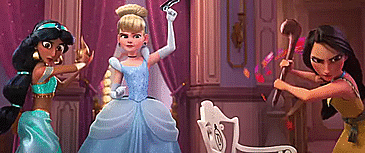
(Gif source)
Yep. I said it. Cinderella is a strong female character.
My girl not only survived in an abusive household, she persistently stayed positive. She worked each day to make the best of an impossible situation, from which she had no means of escape. That takes an insane amount of courage and tenacity.
But Caff, I hear you scream, she needed help to escape!! Well, my imaginary counterargument, so the fuck what? MOST people need help to escape their abusive situations, and there’s no shame in that. Accepting help from someone you trust is the best thing you can do in a situation such as that, and implying otherwise is horribly damaging to victims of abuse.
But she married the prince, you more feebly protest. Yes! She did! She found love and happiness and a great life in a socially influential position! And that’s an amazing message!
So in the flurry of female warriors, let’s not forget Cinderella, who tells people that their terrible circumstances won’t last forever, to stay hopeful and kind, and that accepting help from a trusted friend can lead to a happy life.
Cinderella is a bad bitch, and she deserves her happily ever after.

(Gif source)
Other examples: For some reason, I’m thinking of Sansa from Game of Thrones. When people try to discredit her as a strong character, they often make similar complaints. But both, quite fittingly, end up as queens.
5K notes
·
View notes
Text
Writing Callbacks
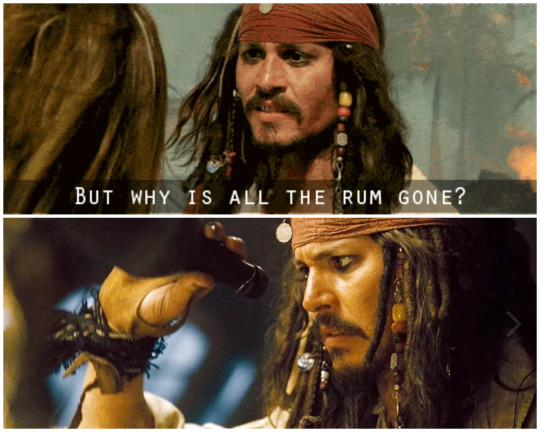
I finally found the correct term for a writing technique that has been in my head a few years! I was at a panel at FanX, when author Dan Willis (not to be confused with Dan Wells) started talking about “callbacks”–I wanted to stop him right then and there and thank him for finally giving me the word (but since we were on a panel, I didn’t think that would be a good idea!).
Of course, it comes from the screenwriting world 🙄 Seriously guys, I’ve never had much of a desire to get into screenwriting, but there are some great ideas (and terminology) in that branch of creative writing (particularly with story structures). So if you want more resources for writing good stories, look into some screenwriting books.
Anyway!
Naturally, I want to now talk about callbacks, since I have the official term (maybe I’m late to the game, and you guys already knew the correct term 😅) But, I’m also going to expand the idea, afterwards.
Callbacks Explained
By definition, a callback is a dialogue technique. It’s when you bring back an old line from earlier in the story.
The Order of the Phoenix film has one of my favorite callbacks in it.
After Harry gets detention, he has to write lines with Umbridge that say “I must not tell lies.”
Later in the film, this happens:

That is a callback.
And audiences love it.
Often callbacks are used in comedy, where the punchline of a joke is pulled back in later for another laugh.
Callbacks can happen in a lot of different places and have a lot of different tones.
However, most of the time, to be effective, the callback must be different than the original line in some way.
This often means changing the context and/or the line itself (by my definition).
So in the Order of the Phoenix example, the line stays the exact same: “I must not tell lies.” But the context is radically different. Originally, Umbridge had the upper hand and was torturing Harry. In the callback, Harry has control. Because we all hate Umbridge and what she did to him so much, it’s really satisfying when he calmly throws it in her face.
But the context can change in a bunch of other different ways too. In Galaxy Quest, Alexander loathes delivering the line “By Grabthar’s hammer …” throughout the film, which is comedic to the audience, but near the climax, the line is flipped on its head when he uses it to comfort a man dying in his arms.
Sometimes you can use the line to illustrate an arc. At the beginning of the story it meant one thing, but by the end, it has a new, more significant meaning. This can be great to emphasize character growth and thematic statements. Mockingjay (the book) does this well in all its references to the “Hanging Tree” lyrics.
Some stories tweak the line. Pirates of the Caribbean uses this comedically throughout the series, when characters make references to the rum being gone.

In Spider-verse, the writers played around with Spider-man’s tag line: with great power, comes great responsibility, and flipped it around so that we have Miles’s dad saying incorrectly “With great ability, comes great accountability” or even having Spider-man himself imply how sick he is of hearing the line. (This is a smart move on the writers’ part, since they are working with a story that has been rebooted four times in 16 years 🤪 Like Peter, we may be tired of the tagline ourselves.)
Often people’s favorite lines to quote are callbacks. Have you noticed?

When writing callbacks, the most important thing to remember is to not be annoying.
If you overuse this technique, it can become annoying.
If you overuse a line in the same context over and over again, it can be annoying.
It’s like telling the same joke over and over and expecting it to be just as effective. It’s not. It gets irritating.
(Unless the joke is that you tell it over and over again.)
You could say the Inigo Montoya’s line is overdone, but it’s intentional and part of the point.
Physical Callbacks
By definition, “callback” relates to dialogue, but I say, why stop there? Why can’t objects or actions work as callbacks too? Well, they can, and actually, they do.
Let’s go back to Spider-verse. The climax is loaded with all sorts of callbacks. But perhaps the most memorable is when Miles defeats Kingpin with the “shoulder touch” he learned earlier in the story. Sure, it does have the same dialogue from earlier (“Heeeeey!”), but really, it’s the action that’s the focal point. That’s the real callback.

What about in Lord of the Rings, when we get that shot of Frodo stroking the ring in the exact same way as Smeagol? Isn’t that an action that conveys a significant arc of character? And it’s an action we’ve seen before.
What about Seamus Finnigan’s magic constantly blowing up in flames through the Harry Potter series–isn’t that like a callback? Finally in the last movie, he’s asked to blow something up intentionally.
And then let’s not forget Napoleon Dynamite and his dancing.
And why can’t this be objects too? Like the changing context of a Mockingjay pin? Or Dobby and his love of socks?
Sure, these all might be a little trickier to pull off in a novel, but not impossible. For actions, just make sure to use the same or similar descriptions and keywords, so you reinforce and emphasize an association. Objects might be a little easier, and they may even take on symbolism, but you make sure they stand out.
I could go on and talk about how callbacks can even extend beyond the text to other texts. Like how Spider-verse calls back to the original Spider-man trilogy a lot in the opening (like with Peter’s dance moves). But I think I’ll call it good for today.
In the end, remember this: Callbacks are effective because they resonate with what the audience saw before.
6K notes
·
View notes
Text
Finding Character Voice
“Character voice” is rather self-explanatory, simply being the unique way a character speaks or narrates. Every character has a voice, some may just stand out more than others, and part of becoming a better writer is learning to work with voices that are unlike your own. Here are some ways to get started on finding a character’s voice once you have a character concept in mind:
Look into their background. What’s their education level? Does the area they come from have any specific sayings? Speech patterns are influenced by a surprising amount of external or upbringing-related elements, especially when it comes to slang and some aspects of grammar, so learn to look beyond the “now” for finding voice.
Personality and mood affect voice. A laid-back person is unlikely to speak or narrate in a snippy tone, unless that subject matter is super important to them. Likewise, a critical person may judge other characters more than another narrator.
Everybody has quirks of speech. Can also be known as ‘verbal tics’, though ‘quirks of speech’ refer to general unique speech patterns as opposed to a specific sound.
Voice is more than just tone. It’s related to perspective and how the character comments on the things they notice. Two characters may see the same tree, but the artist may describe the tree with specific colors whereas a nature-lover may know the species and its stage of life. The information that’s given to the reader through the narrator is a form of voice.
Some techniques for teasing out potential voice are:
Interview your characters with a series of simple questions that get harder and harder. Get personal. See what comes out in how they respond.
Write a letter as if by their hand, about a subject they’re passionate about.
Try acting things out as if you were that character. Have imaginary conversations or test different tones spoken out loud to test the effects.
Create a scene, then test it witch each different character. What do they notice that’s different from others? What’s the order of things that they notice?
Throw each character into the exact same problem. How do they each handle it differently?
————————
Thinking of asking a question? Please read the Rules and Considerations to make sure I’m the right resource, and check the Tag List to see if your question has already been asked. If you can give back, please consider supporting me on Ko-fi or via Venmo Username: JustAWritingAid
1K notes
·
View notes
Text
ways your characters can show varying emotions
to show sadness (grief, sorrow):
- sharply sucking in a breath
- hiccuping from crying so hard
- uncontrollable sobbing
- slumped shoulders, head down
- weather can be used to show emotions — not just rain, but a shining sun and birds chirping contrasts well with a grieving character
- depending on the person, sadness can result in lashing out at others for no reason or shutting everyone out
to show anger (rage, frustration)
- red face, fists clenched
- narrow eyes
- sharp comebacks, gritting teeth
- the air around them is tense
- others may be silent, ignoring whoever they’re angry at
- inhales
- angry. tears.
- kicking, punching, slapping
to show shock (hurt, confusion)
- wide, confused eyes
- freezing in place
- collapsing to their knees
- silent and blank-faced
- ignoring everything else happening around them
to show happiness (joy, delight)
- bright eyes
- crinkles around their eyes from smiling so much
- laughter!
- optimism
- playful, laid back nature
- the weight being lifted off their shoulders
- relaxed sigh
if you’d like me to do more of these, please like and reblog, and follow for more!
15K notes
·
View notes
Text
How to: write pain
Don't make paragraphs about it - battles are supposed to be fast-paced
Describe:
- the object used to harm the character
-where the injury is
-how long the character had had the injury
-how deep the cut is (for blades)
-whether or not the wound triggers other things (dizziness, bleeding)
There are different kinds of pain
punch/blunt force trauma:
-how it feels: aching, a single spike of pain before it fades into an ache, throbbing, numbness
-effects: swelling, bruising, broken bones, unconsciousness, dizziness, concussion, internal bleeding.
stab wound/cut
-how it feels: stinging (shallow wounds), burning
-effects: bleeding (the blood from arteries is a brighter red, like vermilion, the blood from veins is dark crimson), dizziness from the blood loss, unconsciousness, infection (if left unattended), death
gunshot
-how it feels: depends on the caliber bullet, from how far away they were shot and in what place
-effects: same as stab wounds
Things that an injured character may have/do
-heavy, harsh, ragged breathing
-panting, gasping, crying, grunting, hissing, groaning, whimpering, screaming, shrieking, clenching their teeth
-ears ringing, unable to speak
-pressing their hands on the injury to try and stop the bleeding, trembling, eyes rolling up into their head
-vision blurring, room spinning
Where to hit in a fight
temple and jaw - good for a knockout punch, but are near the skull so it will be dangerous if you miss (it can broke/dislocate your fingers)
nose/eyes - messes up the senses and distracts the opponent
neck: can mess up breathing, talking and the spinal cord
inner elbow: can disable the opponent's arm
solar plexus: hard to hit but very effective
liver: causes immediate pain, dizziness and loss of breath
kidneys
groin
outer/inner thighs
knees
-----------------
But not getting into a fight stops the injury for both the opponents :)
(thank you very much for all the support!!! i appreciate every single reblog/like/comment 💕 I'm happy I could help you)
16K notes
·
View notes
Text
WORDS TO USE INSTEAD OF: RUN / RAN
Do you ever find yourself over-using the word “run” (or “ran”) in your writing? Try using these words instead:
sprint / sprinted
dash / dashed
dart / darted
bolt / bolted
race / raced
speed / sped
hurry / hurried
jog / jogged
bound / bounded
hustle / hustled
scurry / scurried
tear / tore
rush / rushed
charge / charged
barrel / barreled
zoom / zoomed
scuttle / scuttled
scamper / scampered
book it / booked it
leg it / legged it
22K notes
·
View notes
